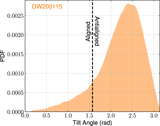Impact of Natal Kicks on Merger Rates and Spin-Orbit Misalignments of Black Hole-Neutron Star Mergers
Abstract
The long wait for the detection of merging black hole-neutron star (BH-NS) binaries is finally over with the announcement by the LIGO/Virgo/Kagra collaboration of GW200105 and GW200115. Remarkably, the primary of GW200115 has a negative spin projection onto the orbital angular momentum, with about 90% probability. Merging BH-NS binaries are expected to form mainly through the evolution of massive binary stars in the field, since their dynamical formation in dense star clusters is strongly suppressed by mass segregation. In this Letter, we carry out a systematic statistical study of the binary stars that evolve to form a BH-NS binary, considering different metallicities and taking into account the uncertainties on the natal-kick distributions for BHs and NSs and on the common-envelope phase of binary evolution. Under the assumption that the initial stellar spins are aligned with the binary angular momentum, we show that both large natal kicks for NSs (≳150 km s-1) and high efficiencies for common-envelope ejection are required to simultaneously explain the inferred high merger rates and the large spin-orbit misalignment of GW200115.
- Publication:
-
The Astrophysical Journal
- Pub Date:
- September 2021
- DOI:
- 10.3847/2041-8213/ac225a
- arXiv:
- arXiv:2108.06538
- Bibcode:
- 2021ApJ...918L..38F
- Keywords:
-
- Astrophysical black holes;
- black hole spin-flip;
- Black holes;
- Stellar mass black holes;
- Neutron stars;
- Gravitational wave astronomy;
- Gravitational wave detectors;
- Gravitational wave sources;
- Gravitational waves;
- 98;
- 160;
- 162;
- 1611;
- 1108;
- 675;
- 676;
- 677;
- 678;
- Astrophysics - High Energy Astrophysical Phenomena;
- Astrophysics - Astrophysics of Galaxies
- E-Print:
- 5 pages, 4 figures, accepted by ApJL
